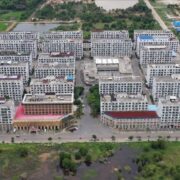Is Mindanao catching up?

Among the first things I called to then President Fidel V. Ramos’ attention after he made me head the National Economic and Development Authority in 1992 was how Mindanao got a disproportionately lower share of the government’s infrastructure budget. I found that share to be less than one-tenth in 1992, even as its contribution to overall gross domestic product was significantly more, estimated to have been around 14-15 percent (no regional disaggregation of our GDP was available before 2000, when Mindanao’s share was 15.2 percent). We in the Ramos economic team worked to triple its share of the government’s capital outlay (infrastructure) budget by 1995, in a deliberate effort to help the traditionally lagging and conflict-ridden island region catch up with the rest of the country. “Peace and development” became Ramos’ mantra for Mindanao, and the first tangible tool to pursue that was via the allocation of the budget.
Now, three decades later, has the gap narrowed between Mindanao and the rest of the country, especially versus Luzon and Metro Manila or the National Capital Region? The good news, is yes, it has. The bad news is, the gap remains rather wide, and worse, the divergence in poverty incidence between Mindanao and the NCR or Luzon has widened. The data show that there’s a long way to go, and much more to do, if we are to have Mindanao catch up, especially with Luzon and the NCR, on various socioeconomic measures and outcomes. Here are some general observations I’ve gleaned from regionally disaggregated data:
Mindanao’s contribution to the overall economy has risen over the years. However, its expansion has been slower than it could be, and it fails to reflect its much higher potential to contribute even more. I’ve examined and done calculations from the Philippine Statistics Authority data on gross regional domestic product (GRDP, or regional GDP) from 2000 to 2024, and noted the following: Mindanao has grown faster (by 257 percent) over the past 24 years than the overall economy (218 percent), with an average annual growth rate of 5.5 percent that outpaced the overall economy’s average annual growth rate of 5.0 percent. This translated over the years to a rising contribution to total GDP, which rose from 15.2 percent in 2000 to 17.1 percent last year. Note that Mindanao accounts for 24 percent of the country’s total population and 34 percent of the total land area. Thus, even the expanded 17 percent share in overall incomes (GDP) remains less than proportionate to its share in the country’s population and land area. In other words, with the right conditions, Mindanao could have contributed much more.
The income gap between Mindanao and Metro Manila, and the rest of Luzon has narrowed. In 2000, the average income (GDP per capita) in Mindanao, stated in constant 2018 prices, was P58,531; in Metro Manila and the rest of Luzon it was P242,562 and P78,813, respectively. Thus, people from Metro Manila had 4.1 times the income of those from Mindanao, while the average Luzon dweller outside the NCR earned 35 percent more. Fast forward to 2024, and the good news is that the respective gaps have narrowed to 3.6 times and 20 percent (average income last year in 2018 prices was P138,529 in Mindanao, P503,483 in Metro Manila, and P166,139 in the rest of Luzon).
Even as Mindanao has been slowly catching up with the north on income, it has fallen behind in fighting poverty. The relative poverty spread between Mindanao and Metro Manila and the rest of Luzon actually widened. In 2003, Mindanao’s poverty incidence of 37.6 percent was 11.7 times that of Metro Manila’s 3.2 percent. The ratio has gone up to 13.8 times, even as Mindanao’s poverty incidence fell to 24.8 percent, because the NCR’s relative drop was steeper, down to only 1.8 percent. Based on headcount, Mindanao had 19.6 times more poor people than NCR in 2003; now it has 25.5 times more. All told, even as Mindanao was catching up with the north on income, it made slower progress in reducing its poor. This is also seen in other human welfare indicators. Stunting among under-five-year-olds remains much higher at 29.5 percent, with the worst rate of 31.9 percent found in the Zamboanga Peninsula, against Metro Manila’s 22.2 percent and Luzon’s 20.9 percent. The functional literacy rate averaged 64.9 percent in Mindanao last year (with the lowest rate of 63.1 percent in the Caraga region), against Metro Manila’s 79.9 percent and the rest of Luzon’s 71.8 percent.
All told, Mindanao still has a lot of catching up to do. Its contribution to our total GDP peaked at 17.23 percent in 2021, but has since been on a downtrend that must be arrested. We need not have a president from Mindanao to fulfill its long-recognized promise, but it continues to need more attention and budgets than it has so far received.


















The smarter energy path for Filipinos